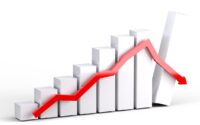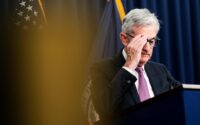Bond Traders Step Up Bets the Fed Will Steer US Economy Into Recession
(Bloomberg) — Bond traders are stepping up wagers that the Federal Reserve will steer the US economy into a recession.
Most Read from Bloomberg
The market reaction to Wednesday’s revelation that Fed officials are prepared to raise interest rates by another half-point this year following the first pause in the central bank’s 15-month hiking campaign proves the point. Short-term yields climbed while long-term ones declined, anticipating a growth slowdown ahead. Likewise, a drop in yields on Thursday was led by long maturities.
The shifts deepened the inversion of the Treasury yield curve, specifically the gap between two- and 10-year securities, to 93 basis points — a level last sustained in March, when this cycle’s 109-basis-point extreme was reached. The price action suggests bond traders are skeptical that policymakers can avoid a so-called hard landing as they continue to press the case for higher borrowing costs in an effort to get a handle on inflation that remains more than double their 2% target.
“The Fed runs the risk of solving one policy error of being too easy for too long with another policy error as they ignore the growing credit contraction and persistent losses from higher rates,” said George Goncalves, head of US macro strategy at MUFG. “The catch-22 is that for them to ease, something now has to break or the economy has to crack.”
It’s not just bond traders who are growing concerned.
Sixty-one percent of respondents in a Bloomberg poll of terminal users conducted in the hours after the Federal Open Market Committee decision said tighter monetary policy will ultimately cause a recession at some point in the next year.
“The Fed was clearly trying to send a hawkish message that they are not quite done yet and don’t think they have made enough progress on inflation,” said Michael Cudzil, portfolio manager at Pacific Investment Management Co. “You see curve flattening and rates not pricing in the full extent of hikes, so the thinking is that these hikes may bite and the Fed is closer to the end.”
Officials left their target range for the federal funds rate unchanged at 5% to 5.25% Wednesday, but projected the key rate will rise to 5.6% by the end of this year, implying two more quarter-point increases, up from 5.1% in March. They also revised higher estimates of core inflation for year-end to 3.9%, from 3.6%, owing to what Chair Jerome Powell called surprisingly persistent price pressures.
Still, markets aren’t convinced borrowing costs will rise as high as central bankers project.
The highest rate on swap contracts for future meetings by early Thursday was around 5.29% for both September and November, with July at 5.26%, compared to a current Fed effective rate of 5.08%.
Read More: Gundlach Doesn’t Think the Fed Will Resume Rate Hikes Soon
The Fed’s aggressive outlook for rate hikes through year-end may be an effort to dash bond-market expectations for cuts in the months ahead, according to Michael de Pass, global head of linear rates at Citadel Securities.
“We’re all in a wait and see mode, and the Fed is likely trying to stop the bond market from pricing in cuts immediately after they stop hiking,” de Pass said. “As the economy evolves, the Fed reaction function and how the market should trade will become clearer.”
For now, investors are left to parse incoming data, much as officials themselves say they’ll be doing. Thursday’s slate included a higher-than-expected number of new jobless claims. The total slightly exceeded the previous week’s, which was the highest in more than a year, an indication of labor-market weakness.
Many bond investors have gravitated to steepener trades in recent months, driven by predictions that the Fed was largely done tightening and that policy easing was around the corner. Those wagers will be challenged should inflation and labor market data prove more resilient than expected in the coming months.
“Here we have the Fed saying we need to be restrictive and stay more restrictive for longer,” Jay Barry, co-head of US rates strategy at JPMorgan, said on Bloomberg TV after the decision. “That’s going to affect the front-end more, while the long-end is more impacted by the trend growth rates. I’m not necessarily surprised we’re seeing the yield curve invert further, if the Fed is saying we have to be more restrictive and stay there for a longer period of time, while there’s nothing to make us think that neutral interest rates or trend growth rates are actually higher.”
The US isn’t the only economy in which markets are signaling an economic contraction after a series of rapid rate hikes.
In Asia trading Thursday, the Australian yield curve inverted for the first time since 2008 as traders increasingly price in a recession. The gap between the 10- and three-year Australian yields fell below minus two basis points, with short-end yields rising after the release of jobs data that proved hotter than expected. In New Zealand, meanwhile, the prospects of economic slowdown have already been realized. Data released Thursday in New Zealand showed that the economy there entered a recession after contracting for the second straight quarter.
(Adds market reaction to US economic data in second and 13th paragraphs.)
Most Read from Bloomberg Businessweek
©2023 Bloomberg L.P.
[ad_2]
Source link


